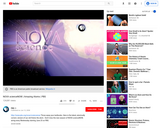
This brief video shows the relationship and movement of particles inside an atom.
- Subject:
- Physical Science
- Material Type:
- Lecture
- Provider:
- NOVA Science
- Provider Set:
- NOVA ScienceNOW
- Date Added:
- 07/15/2013

This brief video shows the relationship and movement of particles inside an atom.
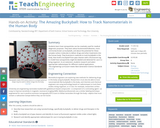
Students learn how nanoparticles can be creatively used for medical diagnostic purposes. They learn about buckminsterfullerenes, more commonly known as buckyballs, and about the potential for these complex carbon molecules to deliver drugs and other treatments into the human body. They brainstorm methods to track buckyballs in the body, then build a buckyball from pipe cleaners with a fluorescent tag to model how nanoparticles might be labeled and detected for use in a living organism. As an extension, students research and select appropriate radioisotopes for different medical applications.

Children experiment with freezing water to observe a state change of water, and discover that it is less dense as a solid (ice) than it is as a liquid (water). Amazing Expanding Ice is an overnight activity requiring 20 minutes of preparation, overnight freezing of the experiment, and 10 minutes of follow-up discussion.

The Amazing Mundo is part of OLogy, where kids can collect virtual trading cards and create projects with them. In this interactive comic strip (also available as a printable PDF), kids are challenged to determine the composition of everyday objects. They learn the variety of things made from materials like sand, metal, bauxite and oil.

This annotated slideshow adapted from KET's Electronic Field Trip to the Forest illustrates how blight decimated the American chestnut tree and the methods scientists use to identify and pollinate the remaining trees to create blight-resistant trees.

Students will research and analyze 5 common American football penalties; identifying why they are fouls and what the appropriate penalty would be.

This article highlights resources related to water from the American Museum of Natural History and at-home activities on ice and water.

This collection of resources, published by the American Museum of Natural History, is intended for educators, parents, students, or anyone who is interested in teaching and learning about science. The resources include activities, curriculum materials, articles, evidence and analysis materials, exhibition materials, and lists of references. Items may be text-based, pedagogical, or multimedia (photos, videos, interactives) in nature. The collection is searchable by keyword or browseable by main topic: anthropology, astronomy, biology, Earth science, or paleontology. There are also special collections, groups of resources organized around specific themes such as Antarctica, ocean life, and the dynamic Earth.
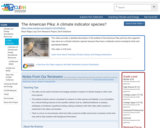
This video provides a detailed description of the habitat of the American Pika and how this organism may serve as a climate indicator species because they have a relatively narrow ecological niche and specialized habitat.
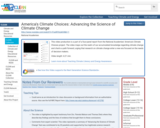
This video production is a part of a four-panel report from the National Academies' America's Climate Choices project. The video maps out the realm of our accumulated knowledge regarding climate change and charts a path forward, urging that research on climate change enter a new era focused on the needs of decision makers.
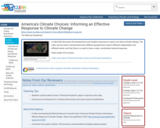
A video that discusses the perspectives and insights necessary to report out about climate change. The video can be used to demonstrate how different perspectives impact different stakeholders and different levels, and that there is a need to have a clear, coordinated national response.
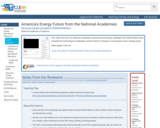
This video from the U.S. National Academies summarizes the energy challenges the United States faces, including the technological challenges, and the need for changes in consumption and in energy policy.

On October 11, 1984, a female American astronaut stepped outside her spacecraft for the first time. Kathryn D. "Kathy" Sullivan had work to do in the payload bay of the Space Shuttle Challenger,

The theme of this guide is: achieving ocean health and balance through investigation and data collection techniques that show the necessity for marine sanctuaries, the effects of fisheries and the management practices being followed in today's oceans.
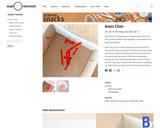
Short pieces of chenille stem arranged inside a box look like a random jumble of line segments—until viewed in the proper perspective.
Note: This activity is detail oriented and time intensive. It’s done by threading a long length of fishing line through twenty small holes, and then attaching short pieces of chenille stem to create a suspended pattern. When you look through a viewing hole, that random-looking pattern resolves into the form of a chair. If you think being a watchmaker is something you’d hate, then you might want to rethink doing this Snack!

The lesson begins with a demonstration introducing students to the force between two current carrying loops, comparing the attraction and repulsion between the loops to that between two magnets. After formal lecture on Ampere's law, students begin to use the concepts to calculate the magnetic field around a loop. This is applied to determine the magnetic field of a toroid, imagining a toroid as a looped solenoid.
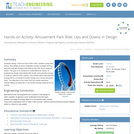
Students design, build and test model roller coasters using foam tubing. The design process integrates energy concepts as they test and evaluate designs that address the task as an engineer would. The goal is for students to understand the basics of engineering design associated with kinetic and potential energy to build an optimal roller coaster. The marble starts with potential energy that is converted to kinetic energy as it moves along the track. The diameter of the loops that the marble traverses without falling out depends on the kinetic energy obtained by the marble.
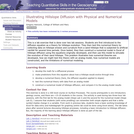
This problem illustrates how numerical theories are developed, how we might test this theory with an analog model, and how numerical models are constructed and the limitations of numerical modeling.
(Note: this resource was added to OER Commons as part of a batch upload of over 2,200 records. If you notice an issue with the quality of the metadata, please let us know by using the 'report' button and we will flag it for consideration.)

This lesson follows the NGSS standards for reviewing analog and digital waves. Students will be able to review the differences and similarities of analog and digital waves. Students will also be able to review how signals sent as analog or digital waves are used.

This lesson follows the NGSS standards for reviewing analog and digital waves. Students will be able to review the differences and similarities of analog and digital waves. Students will also be able to review how signals sent as analog or digital waves are used.